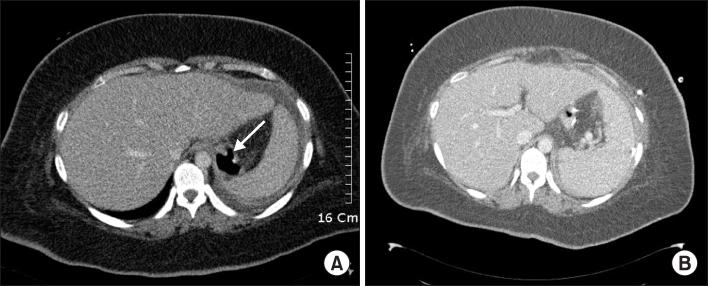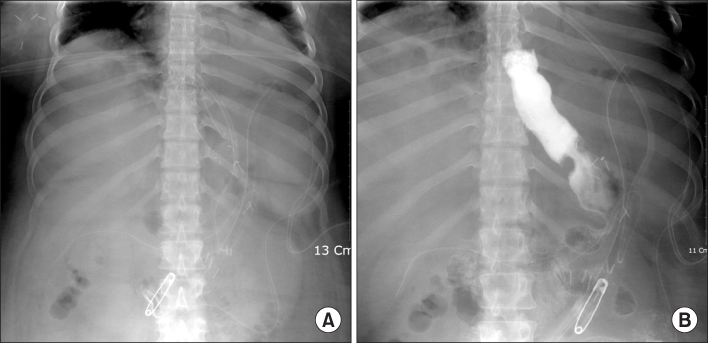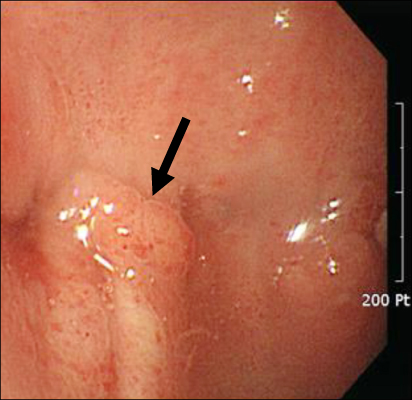Ewha Med J.
2013 Sep;36(2):135-138. 10.12771/emj.2013.36.2.135.
A Case of Endoscopic Closure to Postoperative Leak after Laparoscopic Sleeve Gastrectomy in Patient with Morbid Obesity
- Affiliations
-
- 1Department of Internal Medicine, Ewha Womans University School of Medicine, Seoul, Korea. shimkn@ewha.ac.kr
- 2Department of Surgery, Ewha Womans University School of Medicine, Seoul, Korea.
- KMID: 2171248
- DOI: http://doi.org/10.12771/emj.2013.36.2.135
Abstract
- Laparoscopic sleeve gastrectomy can reduce morbidity and mortality in patients with morbid obesity, but it can cause complications such as a gastrointestinal leak. A 30-year-old morbidly obese female who had type 2 diabetes mellitus and hypertension with estimated body mass index of 40.2 kg/m2 was admitted. Laparoscopic sleeve gastrectomy was performed. On postoperative day 19, a leak was suspicious on physical examination and radiologic findings. Conservative management was performed, but the patient was hemodynamically unstable and imminently septic. After laparoscopic drainage procedure, esophagogastroduodenoscopy was performed and revealed the fistula opening at staple line just below gastroesophageal junction. Fibrin tissue adhesive was injected around the fistula and the esophageal covered stent was inserted to cover the leak. At 14th days after stent insertion, the barium study confirmed no more leak. In this case, we experienced that the esophageal stent insertion with fibrin tissue adhesive injection may reduce recovery time of the fistula developed after laparoscopic sleeve gastrectomy.
Keyword
MeSH Terms
Figure
Reference
-
1. Korea Centers for disease Control and Prevention. 2011 Korea National Health and Nutrition Examination Survey [Internet]. Cheongwon: Korea Centers for disease Control and Prevention;2012. cited 2013 Aug 7. Available from: http://knhanes.cdc.go.kr/knhanes/index.do.2. Lee JM. Body weight change of Korean. Press release of Ministry of Health and Welfare [Internet]. Seoul: Ministry of Health and Welfare;2012. cited 2013 Aug 7. Available from: http://www.mw.go.kr/front_new/al/sal0301vw.jsp?PAR_MENU_ID=04&MENU_ID=0403&page=39&CONT_SEQ=277826.3. Oshiro T, Kasama K, Umezawa A, Kanehira E, Kurokawa Y. Successful management of refractory staple line leakage at the esophagogastric junction after a sleeve gastrectomy using the HANAROSTENT. Obes Surg. 2010; 20:530–534.4. Fuks D, Verhaeghe P, Brehant O, Sabbagh C, Dumont F, Riboulot M, et al. Results of laparoscopic sleeve gastrectomy: a prospective study in 135 patients with morbid obesity. Surgery. 2009; 145:106–113.5. Burgos A, Braghetto I, Csendes A, Maluenda F, Korn O, Yarmuch J, et al. Gastric leak after laparoscopic-sleeve gastrectomy for obesity. Obes Surg. 2009; 19:1672–1677.6. Casella G, Soricelli E, Rizello M, Trentino P, Fiocca F, Fantini F, et al. Nonsurgical treatment of staple line leaks after laparoscopic sleeve gastrectomy. Obes Surg. 2009; 19:821–826.
- Full Text Links
- Actions
-
Cited
- CITED
-
- Close
- Share
- Similar articles
-
- Case Report: Gastrobronchial Fistula after Sleeve Gastrectomy: Treated by Laparoscopic Proximal Gastrectomy with Double Tract Reconstruction
- Simultaneous Laparoscopic Band Removal and Sleeve Gastrectomy: Case Report and Review of Literature
- Laparoscopic Sleeve Gastrectomy in a Morbidly Obese Pediatric Patient With Bardet-Biedl Syndrome
- Early Results of Laparoscopic Isolated Sleeve Gastrectomy without Duodenal Switch in the Treatment of Korean Morbid Obesity
- Robotic Roux-en-Y Gastric Bypass and Robotic Sleeve Gastrectomy for Morbid Obesity: Case Reports





